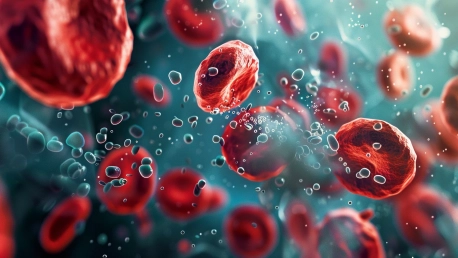Huntington’s disease, a genetic disorder that leads to the gradual death of nerve cells in the brain, has long challenged the medical and scientific communities. Traditional treatments have provided only limited symptom relief, pushing the quest for innovative therapies that can alter the disease’s course. Enter WVE-003, an experimental drug from Wave Life Sciences, which may signify a turning point in addressing this debilitating illness. Leveraging biomarker innovations, WVE-003 aims to lower mutant huntingtin (HTT) protein levels, sparking hope for a new era of Huntington’s treatment.
The Mechanism Behind WVE-003
How WVE-003 Targets Huntington’s Disease
WVE-003 functions as an antisense oligonucleotide, a specialized medication designed to selectively reduce mutant HTT protein levels while preserving the wild-type HTT protein. The mutant HTT protein is widely recognized as the culprit behind neural degeneration in Huntington’s disease, whereas the wild-type HTT protein supports normal brain function. By distinguishing between these two forms, WVE-003 seeks to curb the progression of the disease without compromising essential brain activities. The dual approach targets the mutant HTT protein’s toxic effects on nerve cells while sparing the beneficial protein that supports critical neurological functions. This differentiation is a crucial advancement, as previous treatments struggled to reduce mutant HTT levels without negatively impacting wild-type HTT. The preservation of wild-type HTT alongside the reduction of mutant HTT could provide heightened therapeutic benefits, potentially slowing disease progression while ensuring essential brain functions are retained. This dual-targeting mechanism not only holds promise for Huntington’s patients but may also set a precedent for treating other neurodegenerative conditions with similar pathophysiological underpinnings.
Clinical Trial Insights
In recent placebo-controlled clinical trials, WVE-003 participants achieved a remarkable 46% reduction in mutant HTT protein levels in their cerebrospinal fluid compared to those on placebo. These promising results underscore the drug’s potential to mitigate the neural damage associated with Huntington’s disease. Additionally, the treatment preserved and even enhanced levels of the beneficial wild-type HTT protein, addressing a crucial aspect for maintaining neurological health.Moreover, WVE-003’s ability to reduce mutant HTT protein levels was closely monitored, confirming that the reduction corresponded with a decrease in disease-related biomarkers. The trial results indicated that preserving wild-type HTT while lowering mutant HTT could potentially delay or lessen the severity of Huntington’s symptoms. This therapeutic approach, by targeting the genetic root cause of the disease, represents a substantial leap forward compared to traditional symptomatic treatments. The insights gathered from these trials form the bedrock for further clinical evaluation and eventual regulatory discussions, spotlighting WVE-003 as a leading candidate in the race to find an effective treatment for Huntington’s disease.
The Role of Biomarkers in Clinical Success
Importance of Caudate Atrophy
One of the groundbreaking aspects of WVE-003’s development is its reliance on biomarkers, such as caudate atrophy, to gauge clinical progress. Caudate atrophy, the degeneration of a specific brain region integral to movement and cognitive function, serves as a predictive biomarker for Huntington’s. The correlation between mutant protein reduction and slowed caudate atrophy in WVE-003 trials provides a compelling indicator of the drug’s potential efficacy.This reliance on caudate atrophy as a clinical measure is innovative, emphasizing the importance of structural brain changes as a predictor of disease progression. By focusing on caudate atrophy, researchers can assess the drug’s impact more reliably than through symptomatic evaluation alone. This precise and measurable endpoint helps bridge the gap between molecular changes and observable clinical improvements, offering robust and early insights into the drug’s efficacy. If further validated, the use of caudate atrophy as a decisive biomarker could revolutionize not only Huntington’s treatment development but also the broader landscape of neurodegenerative disease therapies.
Use of Neurofilament Light Chain Levels
Another critical biomarker, Neurofilament Light Chain (NfL) levels, was observed in the trials. Elevated NfL levels often signify nerve cell damage. The trial data displayed an increase in NfL levels among WVE-003 recipients, yet this increase was similar to that seen in placebo groups, indicating the drug’s potential for neuroprotection. Monitoring these biomarkers helps bridge the gap between molecular interventions and tangible clinical outcomes.Elevated NfL levels have been associated with active neurodegeneration, and the observed increase in NfL in both WVE-003 and placebo groups might initially seem concerning. However, the similarity between the two groups suggests that the drug does not exacerbate nerve damage and may, in fact, offer neuroprotective effects. Identifying such subtle nuances through biomarker analysis reinforces the need to marry molecular science with clinical reality. This multi-faceted approach in evaluating WVE-003 ensures a more comprehensive understanding of its impact on Huntington’s pathology, offering a promising horizon for patients and clinicians alike.
Regulatory Strategy and Future Directions
Pathway to Accelerated Approval
Wave Life Sciences is prepared to engage with regulatory authorities to discuss the evidence required for WVE-003’s accelerated approval. The company proposes a robust study encompassing 150 Huntington’s patients over 12 to 18 months, focusing on caudate atrophy as a primary endpoint. This strategic use of biomarkers could expedite the approval process, offering quicker access to potential life-altering treatment for patients.The accelerated approval pathway aims to shorten the timeframe for patients who desperately need new treatments. By leveraging biomarkers such as caudate atrophy, Wave Life Sciences can offer a scientifically rigorous yet expedient route to demonstrating the drug’s efficacy. This approach aligns with evolving regulatory frameworks that increasingly rely on intermediary endpoints to predict clinical outcomes, thus facilitating faster access to promising therapies. Should WVE-003 demonstrate continued success in these advanced studies, it could serve as a model for future drug approval processes in Huntington’s disease and other neurodegenerative conditions.
Comparative Landscape
Several other biopharmaceutical companies are in the race to develop Huntington’s treatments. Competing entities like PTC Therapeutics, Roche, and UniQure are also devising therapies aimed at downregulating mutant HTT expression. The competitive landscape underscores the rigor and innovation present in the field, despite historical setbacks where promising treatments failed to yield clinical benefits.These comparative efforts highlight the multitude of approaches being explored, from small molecule inhibitors to gene therapies. PTC Therapeutics and Roche have focused on similar antisense technologies, while UniQure is pushing the boundaries with gene therapy approaches aiming for longer-lasting effects. The collaborative competitions and shared insights among these companies fuel the collective progress of Huntington’s disease treatments. Each success or failure contributes to a broader understanding of how to effectively target and treat this complex disorder. This dynamic environment, filled with rigorous scientific inquiry and innovation, raises the bar for all players involved, driving the potential for breakthroughs that could one day transform patient outcomes.
Advanced Research and Investor Sentiment
Legacy of Previous Efforts
Wave’s foray into Huntington’s treatment is not without precedent. The company’s earlier candidates were shelved in 2021 due to insufficient potency. This history of initial setbacks casts a shadow of caution over new developments, influencing both clinical approaches and investor perspectives. Furthermore, the field’s collective past struggles with translating molecular success into motor and cognitive function improvements serve as a lesson for future endeavors.Previous setbacks have reinforced the importance of thorough clinical evaluation and rigorous trial design. While these initial disappointments have made investors cautious, they also underscore the resilience and adaptability of the scientific community in addressing Huntington’s disease. Lessons learned from past failures continue to inform current methodologies, ensuring that new candidates like WVE-003 are developed with better-targeted mechanisms and more reliable biomarkers. The cautious optimism that now surrounds these endeavors reflects a matured understanding of the complexities involved, fostering a more robust approach to developing effective treatments.
Investor Reactions and Market Implications
Despite the positive clinical data, Wave’s stock experienced an 11% dip on the news day. This investor reaction highlights the cautious optimism prevalent in the market, stemming from previous disappointments in the Huntington’s treatment paradigm. Nonetheless, the new biomarker-driven strategy could potentially redefine success metrics, giving rise to renewed optimism in the field.Investor sentiment often plays a pivotal role in the progression and support of drug development initiatives. The initial market response to WVE-003’s trial data, influenced by historical challenges and the inherent risks of drug development, reflects a cautious yet hopeful approach. Investors recognize the transformative potential of WVE-003 but remain mindful of the complexities and uncertainties that still lie ahead. This cautious optimism, however, can serve as a catalyst for sustained funding and strategic partnerships, ensuring the continued progress and refinement of promising treatments like WVE-003.
Collaborative Efforts and Broader Implications
Potential Partnerships and Collaborations
Wave Life Sciences’ collaboration opportunities, notably with biotech giant Takeda, signal a promising future. Strategic alliances could facilitate resource pooling, expertise exchange, and ultimately, accelerated drug development. This collaborative spirit is crucial for overcoming the complex challenges posed by Huntington’s disease.Partnerships with established entities such as Takeda can significantly bolster Wave’s research and development capabilities. Leveraging Takeda’s extensive experience and resources, Wave can expedite clinical trials, enhance regulatory strategies, and potentially broaden the scope of WVE-003’s application. These collaborations embody the synergistic approach needed to tackle multifaceted diseases like Huntington’s, where multidisciplinary expertise and shared goals drive innovation and success. By aligning with key industry players, Wave positions itself strongly in the competitive landscape, ready to translate promising molecular insights into impactful clinical solutions.
Broader Impact on Neurodegenerative Disease Treatment
Huntington’s disease is a hereditary disorder characterized by the progressive deterioration of nerve cells in the brain, presenting a formidable challenge to the medical and scientific communities. Existing treatments have primarily focused on alleviating symptoms rather than addressing the root cause, prompting an ongoing search for more effective therapies that could potentially alter the trajectory of the disease. Wave Life Sciences introduces WVE-003, an investigational drug that may mark a significant breakthrough in the treatment of Huntington’s disease. This promising therapy utilizes advanced biomarker technology to target and reduce levels of the mutant huntingtin (HTT) protein, which is implicated in the disease’s progression. By directly addressing the underlying genetic factors, WVE-003 offers renewed hope for mitigating the debilitating effects associated with Huntington’s.The innovation represented by WVE-003 embodies a critical shift in therapeutic strategies, moving beyond symptom management to potentially modifying the course of the disease itself. This approach underscores the evolving landscape of biomedical research, where precision medicine and genetic insights are harnessed to combat complex neurodegenerative disorders. While still in the experimental stages, the development of WVE-003 exemplifies the tireless efforts of researchers striving to transform the future of Huntington’s disease treatment, offering a beacon of hope to those affected by this relentless condition.









